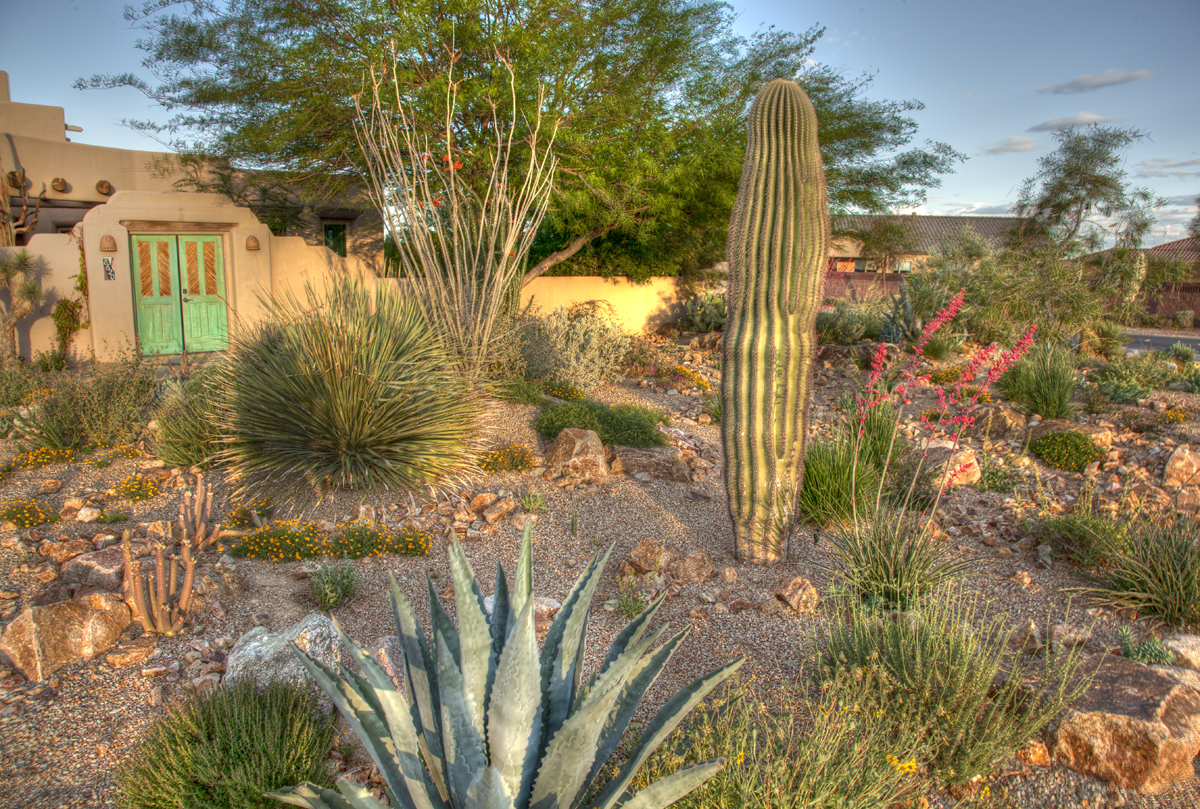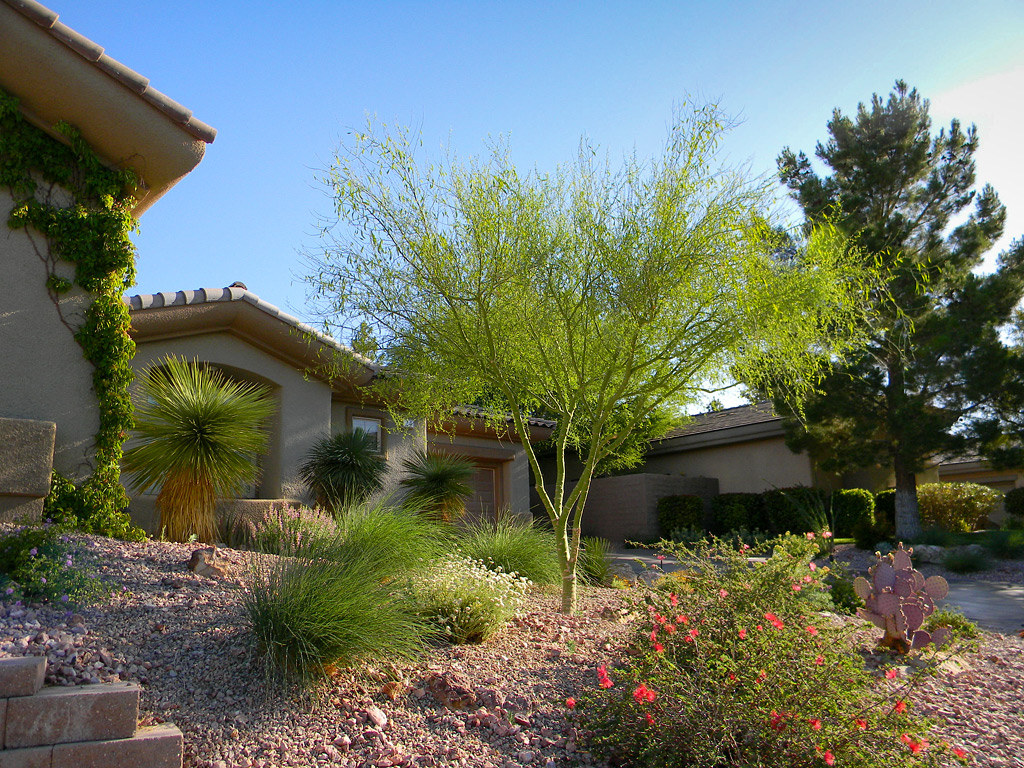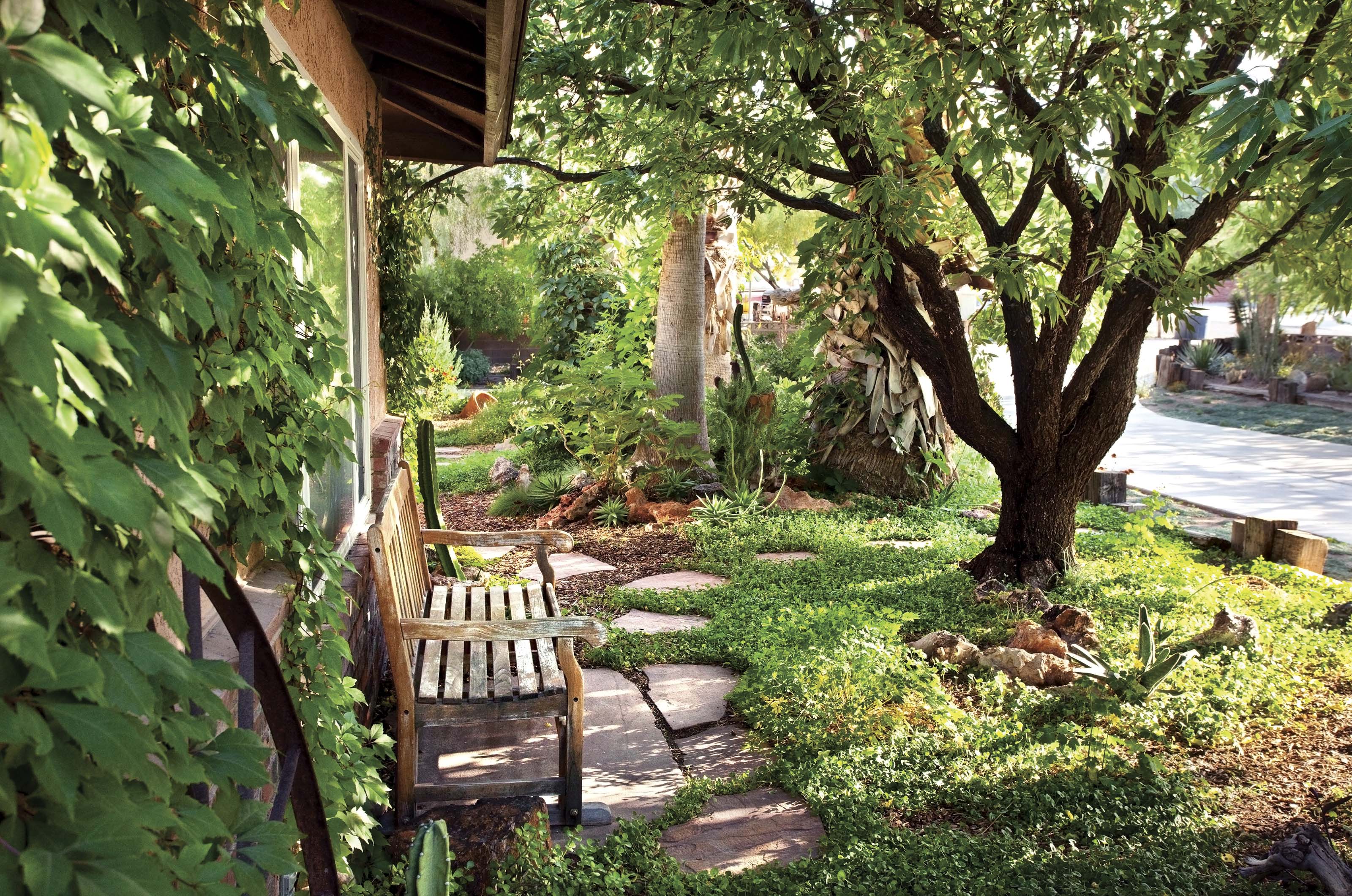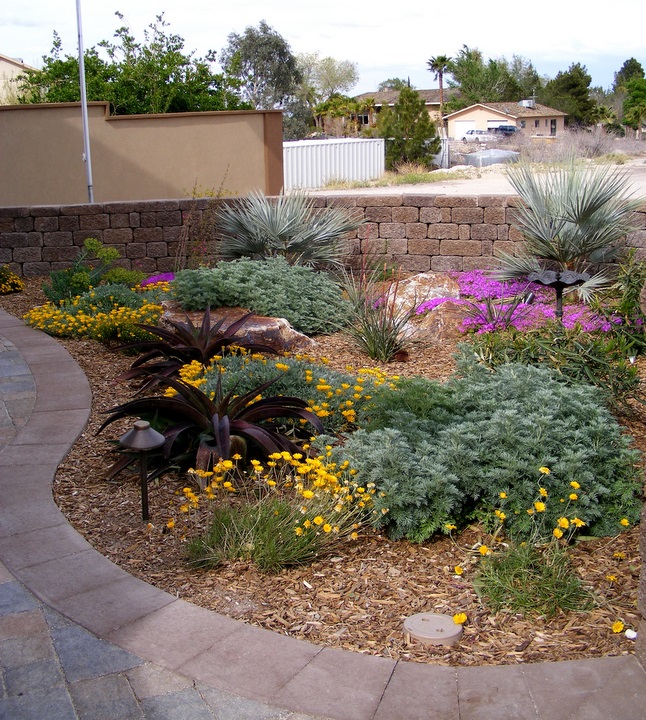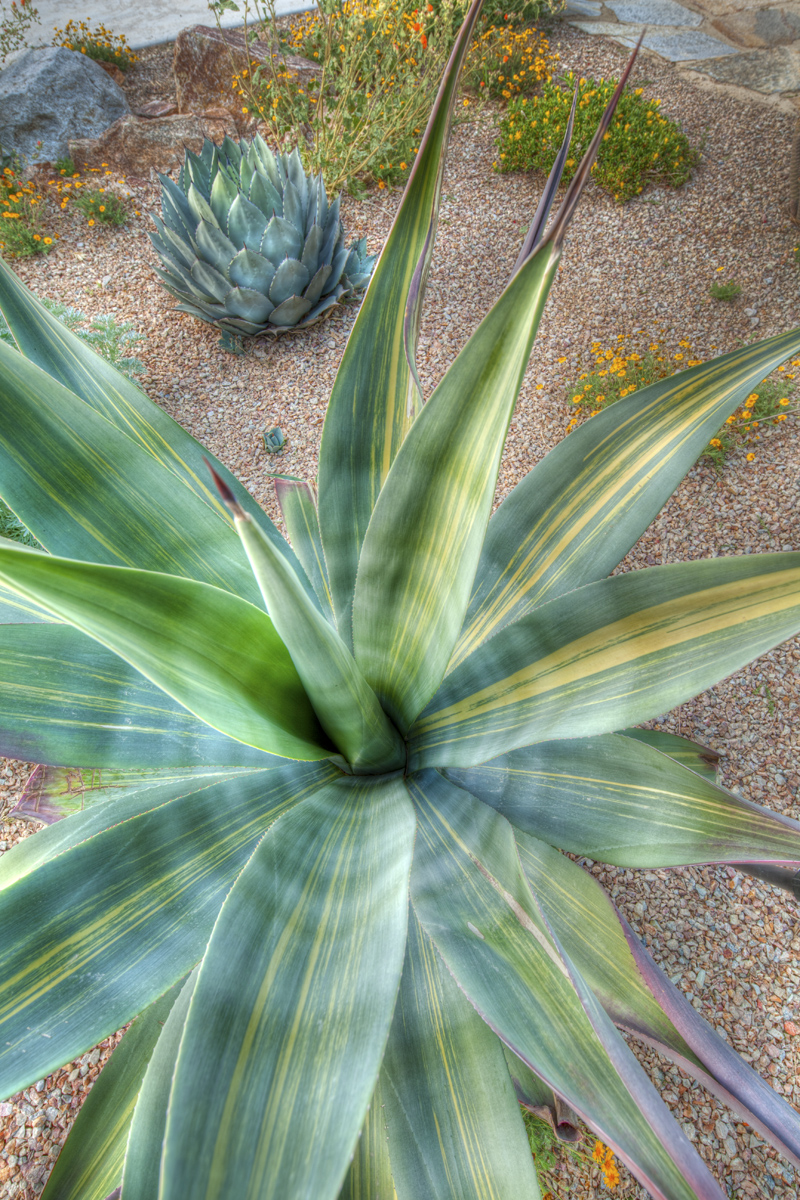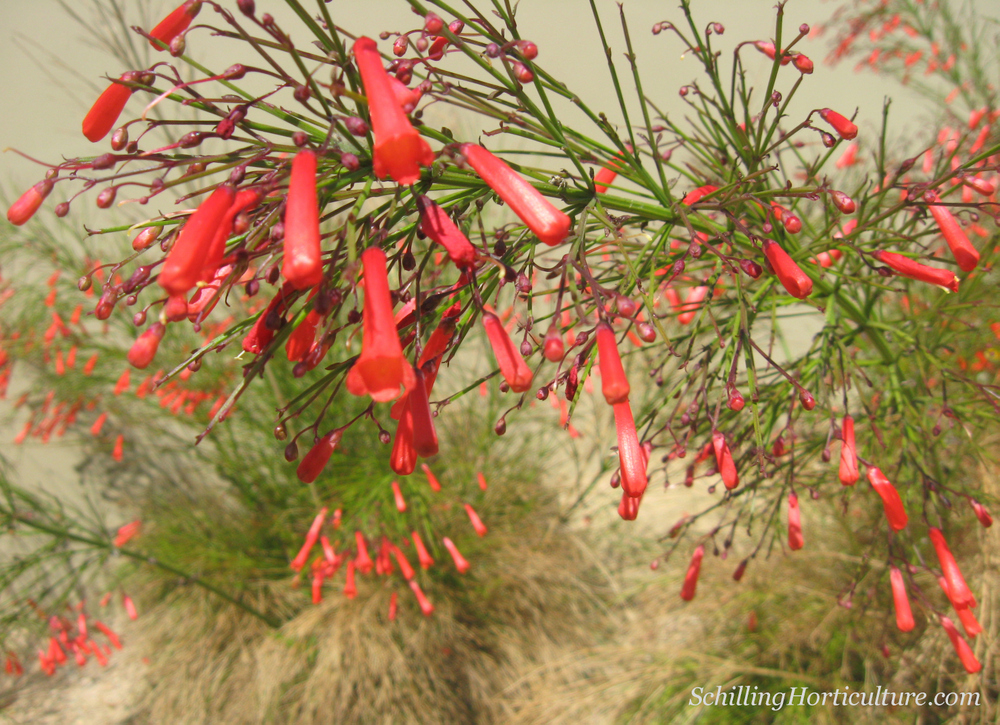What is “Landscape Sustainability” in our Desert Climate?
“Landscape sustainability” means attempting to minimize the resources that go into our landscapes while minimizing the waste that comes out of them. Sustainability in our region is related to “Xeriscaping” (another familiar word used in desert landscaping), but the two terms are not the same: Xeriscaping involves practical design, short-term goals and specific implementation techniques used in the construction of an efficient, functional arid-region landscape. Sustainability implies a more holistic, philosophical and long-term approach toward incorporating nature and climate-friendly processes – based on principles such as balance, harmony, preservation and conservation – into our urban, residential communities. We utilize Xeriscape techniques to help arrive at greater levels of sustainability in our landscapes.
At the core, sustainable landscapes seek above all to conserve and responsibly use our most precious resource: water. Demand for water in the western U.S. is at an all-time high, while the supply of it is at a record low. Sustainable landscapes drastically reduce the need for water and the potential wasting of it.
In addition to optimizing the health and structure of our landscape soils, sustainable landscapes utilize trees, shrubs and flowers – very often native plant life – that are known to thrive in arid desert habitats. Sustainable landscapes reduce yard and construction waste, as well as pollution and contamination, through appropriate material and maintenance choices.
It is important to understand and visualize what a sustainable landscape is not: it is not a scrubby, isolated cactus stuck in the middle of a hot, dusty yard surrounded by oceans of heat-reflecting rock and gravel. Conversely, it is a lush, picturesque outdoor living space that invokes emotions of beauty, vitality, harmony and economy. Landscapes that correctly employ sustainable principles are anything but dull and lifeless.
Following are the core tenets that make up landscape sustainability:
Proper Planning and Design
Before a single seed is planted, sustainable landscaping carefully considers the natural topography, orientations and microclimates of the existing natural landscape. A rigorous attempt is made to design and install for maximum energy conservation. Trees are selected and strategically placed to shade habitable areas in the summer, warm the same areas in the winter, and provide wind protection if desired. Specific zones are intentionally created to encourage visitation by wildlife and to keep plants with similar needs grouped together.
Appropriate Plant Choice
Unsurprisingly, the best choice for fostering a thriving sustainable plant community is to select species that grow natively in our region. Next best are those plants that readily acclimate to the hot, dry conditions of the Mojave Desert. Sustainable plants get by on little water, little or no pruning and little or no fertilization. Native or adapted plants are also better equipped to fend off pests, diseases and stress. Equally important, if not more so, to plant selection is plant placement in the landscape. Sustainability considers the mature size of the desired tree or plant prior to buying and planting, after which a suitable planting site gives the tree or shrub room to grow and to achieve its full genetic potential.
Soil Improvement
Improving the health and fertility of planting soils is a key component of sustainability. The incorporation of either small or plentiful quantities (determined by the affected plant species) of organic material (namely compost, purchased soil amendments or decomposed manure) into the soil triggers the creation of beneficial biological communities, and aids tremendously in water retention, drainage and nutrient dispersal. When fertilizers are required to supplement a nutrient deficiency in the soil, organic choices, as opposed to chemical, are preferred to enhance soil vitality and to decrease the chances of soil and groundwater contamination.
Efficient Irrigation
Inefficient water use in the landscape contributes to declining plant health, wasteful run-off, elevated water bills and unsightly staining on hardscapes. Sustainability addresses this issue through low-water use plants, responsible timer clock settings and drip systems complete with low-flow emitters that deposit the correct amount of water directly to root zones.
Practical Lawns and Turf Areas
Lawns situated in arid climates generally require an inordinate amount of water and maintenance, particularly during our hot summers, to keep healthy and green. Sustainable landscapes reduce or eliminate the use of grass lawns and turf. Many water districts incentivize homeowners through rebates to replace existing lawns with water-efficient shrubbery. If grass areas are ultimately desired, one step toward sustainability is to leave mowed grass clippings on the lawn to naturally decompose and nourish the soil below. A popular saying states that if the only time you step on your lawn is to mow it, you won’t miss it much – if at all – when it’s gone.
Integrated Pest Management
One of the most destructive environmental practices in our landscapes is irresponsible pesticide use. When improperly used, these chemicals can actually harm plants, kill beneficial wildlife and contaminate our soils and ground waters. Very often the best approach to pest management is to simply let nature take its course. If pest management is needed, opt for the least toxic method first, which can be as simple as a strong steam of water from a hose. Other options include the introduction of beneficial predators and the use of organic agents such as neem or spinosad.
Beneficial Mulches
The benefits of mulch – defined as the 1”-3” layer of material deposited on top of the existing soil – on any planted landscape are well documented. Organic mulches, such as shredded wood or bark chips, provide nutrients to the soil as they breakdown, protect roots from heat and cold, discourage weeds and erosion, enhance water and gas permeability and offer a pleasing groundcover to the eye. Even rocks and gravel can be used as mulch for particularly arid landscape schemes.
Composting
Composting is the ultimate expression of sustainability, recycling and rejuvenation. Finding an out-of-sight, undisturbed section of the yard or landscape to deposit vegetative kitchen scraps and yard waste for natural decomposition will eventually reward us with the most beneficial, cost-effective and nutrient-packed material to add back into garden soils and landscape. Contemporary composting equipment is very sanitary, economical and convenient to use. The stigma that composting is dirty, smelly and offensive is unwarranted, and these excuses are no longer acceptable given our current rate of natural resource depletion and landfill contributions.
Edible Gardens with Vegetables, Fruits and Herbs
Although producing healthy, delicious edibles from home gardens can be challenging, there has never existed as much research, knowledge and tools as the present day to help us rise to the challenge. Harvesting one’s own food produces a satisfying sense of accomplishment, stewardship and self-reliance, not to mention an efficient means to reduce expense and trips to the supermarket. Many types of trees and plants that produce fruits, nuts, vegetables and herbs adapt particularly well to our warm, dry, sunny climate.
Eco-Friendly Equipment and Décor
Options exist to cut down on energy use and emissions through electric-powered tools and equipment. Solar lighting can be used to accent landscape features at night. Water features should be kept small in scale to offset evaporation loss. Sustainability encourages the reuse of chemically-inert construction materials and of course the recycling of all applicable materials where possible.
What Landscape Sustainability Really Means.
After reading the above, the concept of landscape sustainability may seem overly-complex and arduous to implement, but once you grasp and appreciate the underlying premises, you see how all the facets come together to create a thriving, healthy eco-system in balance with the natural world around it. Once put into practice, the benefits of sustainability to ourselves and to the community are very tangible:
- Sustainability is easy on the environment – human beings don’t seem to be genetically pre-disposed to integrate seamlessly and harmlessly into our natural world around us. Rather, we attempt to warp, exploit and deplete our environs, often leaving it in much worse condition than we found it. Sustainability represents our opportunity to reverse this trend.
- Sustainability is easy on the eyes – with an endless variety of plant life, colors, textures and palettes from which to choose, it isn’t difficult to arrive at an attractive, visually-appealing landscape scheme that communicates an entire spectrum of emotions – from vibrant energy to stimulating equilibrium to soothing tranquility.
- Sustainability is easy on the wallet – astute planning and thoughtful implementation of sustainable practices can over time a) reduce water, energy and maintenance bills, b) earn substantial rebates where available from water suppliers, and c) elevate property values.
We at Schilling Horticulture Group hope you will embrace the concept of sustainability and ask us to incorporate as many of the above principles as possible into your landscape designs, installations, renovations and maintenance programs. The burden and privilege rests on all of us do our respective parts, as minimal as they may seem, to appreciate, learn from, and preserve our earthly home and all its processes that give us life. It’s very much worth the effort.






